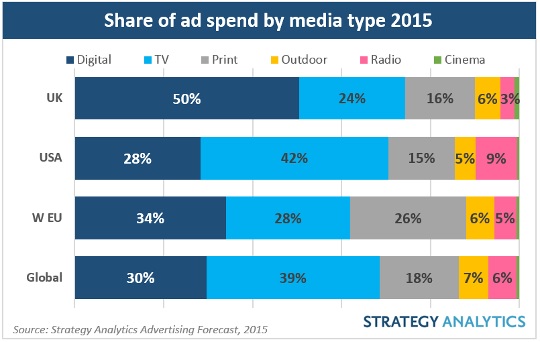En nuestra búsqueda de traerles los mejores consejos para realizar una publicidad efectiva les traemos este interesante articulo de Luis Maram, experto en Marketing Online
La publicidad hoy se llama contenido
Basta ver cómo ha crecido su búsqueda en los últimos años… y es que después de todo ¿quién quiere ver banners invasivos?
La inversión en contenidos y redes sociales sigue creciendo; tal vez puede parecer que es de forma moderada pero la realidad es que el ascenso no se detendrá. Los grandes monstruos publicitarios que se erigieron omnipotentes en la era de los Mad Men están decayendo; entramos a una nueva fase. Las agencias creadoras de contenidos están ganando terreno, boutiques digitales y pequeños estudios creativos se perfilan como los ganadores de los presupuestos.
Esta nueva generación de marketers sin pomposas maestrías detrás de ellos, saben que hoy los productos “no se venden”; entienden que las marcas necesitan humanizarse y crearcontenido inspirador sin tener como objetivo primario el ROI duro… —¿Cómo?— gritarán los mercadólogos de vieja cuña… —¿Cómo? ¡Imposible! estúpidos niños imberbes que seguro llevarán a sus marcas a la quiebra si no piensan en retorno de inversión—
Lo que ellos no han entendido es que las generaciones digitales no comprenden el concepto anuncio como una pieza enfocada a persuadirme en la compra de un bien; eso es un concepto obsoleto. Los nativos digitales se enganchan hoy con contenidos como series y películas que puedan devorar en Netflix… (el cord cutting es natural en ellos); con spots que cuenten historias en sus redes sociales; con sitios que los entretengan o les proporcionen conocimiento en su propio lenguaje, desde notas irrelevantes BuzzFeed, Upworthy o UPSOCLhasta temas algo más serios devenidos de Linkedin, TED, Inc. o FastCompany; los jóvenes hoy están más atrapados en el crowdsourcing, la publicidad nativa, los streamings y el storytelling que en los burdos anuncios de 20 o 30 segundos que crearon imperios publicitarios de la mano de figuras míticas como Don Draper.
Marketing hoy
Este es el marketing actual, dedicado a entretener, a enamorar a inspirar… no a vender. Las ventas llegarán solas como consecuencia del engagement que logremos generar. Los grandes monstruos publicitarios del pasado, tan enfocados en TV y print no podrán dar la batalla.
¿Están muertas las agencias? ¿Están muertos los creativos cargados de “chispa” para crear Big Ideas y copys? ¿Está muerta la publicidad? La respuesta es que sí bajo la forma en que la conocimos. Es obvio que la palabra no desaparecerá, ni los presupuestos, ni la creatividad; los titanes se transformarán, tendrán que invertir grandes sumas en ello y eliminar planillas de empleados obsoletas; no todas las agencias sobrevivirán, sino como dijo Darwin, lo harán las que logren adaptarse.
Si los Don Draper se extinguen ¿quiénes tomarán su lugar? Los directores de contenido y todos sus equipos, orientados en crear mensajes líquidos capaces de colocarse y viralizarse en v¡deos de dos minutos para Facebook, textos de 2,500 caracteres para blogs, infografías coloridas para Pinterest, telegramas de 140 caracteres para Twitter, streamings directos para Periscope o Meerkat e incluso extenderse a apps, interactivos, experiencias, eventos y hasta películas. Que le pregunten a Dove, a Nike, a Coca-Cola, a LEGO, a American Express, a Always, a Chipotle, a McDonald´s, a Starbucks que ya trabajan en ese sentido desde hace algunos años.
https://youtu.be/xCLQeHeiBoY
https://youtu.be/doNSOLDJyKU
La visión del contenido
Pensar en contenido como el aburrido post en un blog es tener una visión miope del marketing. Contenido hoy es cualquier mensaje que una marca haga llegar su audiencia con el fin de atraerlo, inspirarlo, convertirlo y volverlo recurrente… y por qué no, hasta un evangelizador.
Esto no es nuevo, Bill Gates lo visualizó desde 1996 con un artículo adelantado a su tiempo. Hoy a casi 20 años, lamentamos decírselo a los publicistas de vieja cuña… Gates tenía razón, y el contenido es el rey. Larga vida al rey.
Aquí el inmortal artículo del fundador de Microsoft.
Content Is King – Bill Gates (1/3/1996)
Content is where I expect much of the real money will be made on the Internet, just as it was in broadcasting.
The television revolution that began half a century ago spawned a number of industries, including the manufacturing of TV sets, but the long-term winners were those who used the medium to deliver information and entertainment.
When it comes to an interactive network such as the Internet, the definition of “content” becomes very wide. For example, computer software is a form of content-an extremely important one, and the one that for Microsoft will remain by far the most important.
But the broad opportunities for most companies involve supplying information or entertainment. No company is too small to participate.
One of the exciting things about the Internet is that anyone with a PC and a modem can publish whatever content they can create. In a sense, the Internet is the multimedia equivalent of the photocopier. It allows material to be duplicated at low cost, no matter the size of the audience.
The Internet also allows information to be distributed worldwide at basically zero marginal cost to the publisher. Opportunities are remarkable, and many companies are laying plans to create content for the Internet.
For example, the television network NBC and Microsoft recently agreed to enter the interactive news business together. Our companies will jointly own a cable news network, MSNBC, and an interactive news service on the Internet. NBC will maintain editorial control over the joint venture.
I expect societies will see intense competition-and ample failure as well as success-in all categories of popular content-not just software and news, but also games, entertainment, sports programming, directories, classified advertising, and on-line communities devoted to major interests.
Printed magazines have readerships that share common interests. It’s easy to imagine these communities being served by electronic online editions.
But to be successful online, a magazine can’t just take what it has in print and move it to the electronic realm. There isn’t enough depth or interactivity in print content to overcome the drawbacks of the online medium.
If people are to be expected to put up with turning on a computer to read a screen, they must be rewarded with deep and extremely up-to-date information that they can explore at will. They need to have audio, and possibly video. They need an opportunity for personal involvement that goes far beyond that offered through the letters-to-the-editor pages of print magazines.
A question on many minds is how often the same company that serves an interest group in print will succeed in serving it online. Even the very future of certain printed magazines is called into question by the Internet.
For example, the Internet is already revolutionizing the exchange of specialized scientific information. Printed scientific journals tend to have small circulations, making them high-priced. University libraries are a big part of the market. It’s been an awkward, slow, expensive way to distribute information to a specialized audience, but there hasn’t been an alternative.
Now some researchers are beginning to use the Internet to publish scientific findings. The practice challenges the future of some venerable printed journals.
Over time, the breadth of information on the Internet will be enormous, which will make it compelling. Although the gold rush atmosphere today is primarily confined to the United States, I expect it to sweep the world as communications costs come down and a critical mass of localized content becomes available in different countries.
For the Internet to thrive, content providers must be paid for their work. The long-term prospects are good, but I expect a lot of disappointment in the short-term as content companies struggle to make money through advertising or subscriptions. It isn’t working yet, and it may not for some time.
So far, at least, most of the money and effort put into interactive publishing is little more than a labor of love, or an effort to help promote products sold in the non-electronic world. Often these efforts are based on the belief that over time someone will figure out how to get revenue.
In the long run, advertising is promising. An advantage of interactive advertising is that an initial message needs only to attract attention rather than convey much information. A user can click on the ad to get additional information-and an advertiser can measure whether people are doing so.
But today the amount of subscription revenue or advertising revenue realized on the Internet is near zero-maybe $20 million or $30 million in total. Advertisers are always a little reluctant about a new medium, and the Internet is certainly new and different.
Some reluctance on the part of advertisers may be justified, because many Internet users are less-than-thrilled about seeing advertising. One reason is that many advertisers use big images that take a long time to download across a telephone dial-up connection. A magazine ad takes up space too, but a reader can flip a printed page rapidly.
As connections to the Internet get faster, the annoyance of waiting for an advertisement to load will diminish and then disappear. But that’s a few years off.
Some content companies are experimenting with subscriptions, often with the lure of some free content. It’s tricky, though, because as soon as an electronic community charges a subscription, the number of people who visit the site drops dramatically, reducing the value proposition to advertisers.
A major reason paying for content doesn’t work very well yet is that it’s not practical to charge small amounts. The cost and hassle of electronic transactions makes it impractical to charge less than a fairly high subscription rate.
But within a year the mechanisms will be in place that allow content providers to charge just a cent or a few cents for information. If you decide to visit a page that costs a nickel, you won’t be writing a check or getting a bill in the mail for a nickel. You’ll just click on what you want, knowing you’ll be charged a nickel on an aggregated basis.
This technology will liberate publishers to charge small amounts of money, in the hope of attracting wide audiences.
Those who succeed will propel the Internet forward as a marketplace of ideas, experiences, and products-a marketplace of content.
¿Está la publicidad muerta? Muchos se han aventurado a asegurarlo, aún antes de que el marketing digital irrumpiera con toda su fuerza. The Fall of Advertising & the Rise of PR fue escrito por Al y Laura Ries y anunciaban ya un cambio… pero no… no fueron las relaciones públicas las que tomaron el lugar de la publicidad como ellos presuponían… quien está heredando el trono es el contenido.




Dejar una Respuesta